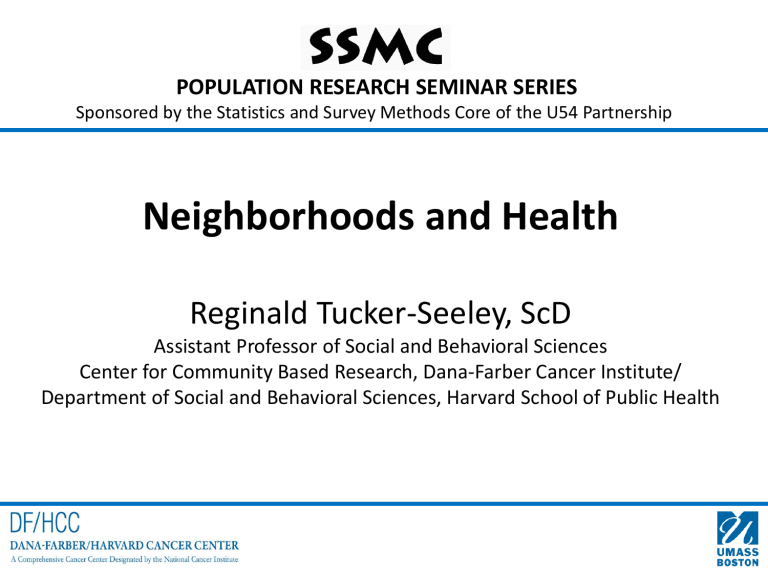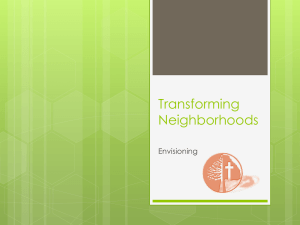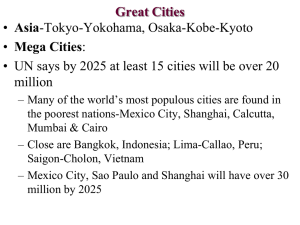Neighborhoods and Health

POPULATION RESEARCH SEMINAR SERIES
Sponsored by the Statistics and Survey Methods Core of the U54 Partnership
Neighborhoods and Health
Reginald Tucker-Seeley, ScD
Assistant Professor of Social and Behavioral Sciences
Center for Community Based Research, Dana-Farber Cancer Institute/
Department of Social and Behavioral Sciences, Harvard School of Public Health
Overview
• Background
• Challenges to research on the association between neighborhoods and health
• Interventions at the neighborhood level
– Intervening on the residents
– Intervening on the place/space
– Intervening on the residents and the place/space
• Summary/Conclusions
Background
• Where we live matters
Background
• Characteristics of places associated with health/health behavior:
– Safety (Tucker-Seeley, et al. 2009; Bennett, et al.
2007)
– Aesthetics (Hoehner, et al. 2005)
– Physical structure (Brownson, et al. 2009)
– Food stores (Sharkey, et al. 2009)
Background
• Proximity and the density of liquor stores associated with health behavior and health status of residents (Cunradi, 2010; Romley, et al, 2007; LaVeist et al, 2000)
• Association between minority concentration, alcohol outlet density, and alcohol problems
(Alaniz, 1998)
Source: RWJF Commission to Build a Healthier America, Where we live matters to our health
What is a neighborhood?
• Block(s)
• Administrative boundary (e.g. census)
• Area between natural/man-made barriers
What is a neighborhood?
What is a neighborhood?
Neighborhood Definition
• The definition of “neighborhoods” is a difficult one to capture; as “neighborhoods” have emergent properties that are created and defined both by larger structural forces AND by the residents within them.
Neighborhood Definition
(Sampson, 2012)
• Neighborhoods are “spatial units with variable organizational features, and…are nested within..larger communities. Neighborhoods vary in size and complexity depending on the social phenomenon under study and the ecological structure of the larger community.”
(Sampson, 2012, pg. 54).
What is a “good” neighborhood?
• Safe to walk to destinations
• Aesthetically pleasing (attractive features, well-maintained buildings)
• Trust fellow neighbors
• Can count on neighborhoods to help keep neighborhood well-maintained
• Stable/long-term residents
What is a “bad” neighborhood?
• Not safe (fearful of crime)
• Transient residents
• Dilapidated buildings
• Unfavorable retail
– liquor stores
– alternative financial institutions (check cashers, pawn shops)
– Empty storefronts
Neighborhood environment
• Where we live matters
– Quality of the neighborhood environment influences health and health behavior
– Safety
– Aesthetics
– Physical structure
• Neighborhood service environment
– What are the options available to the residents for services?
– Are there specific mixes of services associated with resident behavior?
– Is the current mix of services what the residents want?
Sampson (2012)
• “What happens in one neighborhood is tightly connected to adjacent neighborhoods, creating a “ripplelike” effect that encompasses the entire city.”
Neighborhood Boundaries
• Perceived “neighborhood” boundaries may vary between residents in an area (Coulton, et al, 2013)
• Different neighborhood sizes used in research may work differently across variables and behaviors (Lee and Moudon, 2006)
• “the effects of area-based attributes could be affected by how contextual units or neighborhoods are geographically delineated and the extent to which these areal units deviate from the true causally relevant geographic context” (Kwan, 2012)
Neighborhoods and Health Theory
• No widely accepted theory that clearly outlines constructs, describes mechanisms and links to health behavior/health
– Ross (2000) hypothesizes that neighborhoods can affect behavior through a contagion mechanism where people’s behavior is influenced by those around them and a structural mechanism where neighborhood environments organize the opportunities and resources available to the residents that can influence health behavior.
Sampson (2012)
• “How do individual choices combine to create social contexts that then constrain choices?”
– At multiple levels
– How do we capture the individual choices and social contexts and their influence on constrained choices in our theories and methods?
Model of the influence of neighborhood and individual level resources on health
Residential segregation by race/ethnicity and socioeconomic position
Neighborhood physical environments
Environmental exposures
Food and recreational resources
Built environment
Aesthetic quality/natural spaces
Services
Quality of housing
Behavioral mediators
Stress
Inequalities in resource distribution
Neighborhood social environments
Safety/violence
Social connections/cohesion
Local institutions
Norms
Health
Personal Characteristics
Material resources
Psychosocial resources
Biological attributes
Source: Diez-Roux and Mair, 2010
Model of the influence of neighborhood and individual level resources on health
City level policies
•Zoning
Historical housing/ mortgage practices
•“Redlining”
Residential segregation by race/ethnicity and socioeconomic position
Neighborhood physical environments
Environmental exposures
Food and recreational resources
Built environment
Aesthetic quality/natural spaces
Services
Quality of housing
Behavioral mediators
Stress
Inequalities in resource distribution
Neighborhood social environments
Safety/violence
Social connections/cohesion
Local institutions
Norms
Health
Personal Characteristics
Material resources
Psychosocial resources
Biological attributes
Source: Diez-Roux and Mair, 2010
Model of the influence of neighborhood environment
Neighborhood
Environment
• Land Use
• Public services
• Health care resources
• Financial
Resources
• Retail/Commercial
Experience of the
Neighborhood
• Attachment
• Sense of Community
• Feeling of relegation
• Residential captivity
• Internalized Stigma
• Perceived Safety
Psychological
Well-Being
• Stress
• Anxiety
• Depressive
Symptoms
Social Cognitive
Factors
• Life Values
• Knowledge/beliefs
• Self-esteem
• Self-efficacy
• Locus of Control
Health Behaviors
• Physical activity o
Recreation o
Transportation
• Diet
• Smoking
• Alcohol
Consumption
• Health care utilization
Other Risk Factors
• Obesity
Based on Chaix, 2009
What do we really mean by
“neighborhood effects”?
• What are “neighborhood/place effects” really capturing?
Segregation and Place
“The research literature documents that “places” which are racially segregated with high concentrations of blacks or Hispanics tend to be places with limited opportunities and failing infrastructure, resulting from a lack of investment in social and economic development. The result is a community that produces bad health outcomes. So, racial inequalities in health status and outcomes are predominantly the result of place. Race helps to determine place, and in turn, place influences health.”
(Segregated Spaces, Risky Places: The Effects of Racial
Segregation on Health Inequalities by the Joint Center for Political and
Economic Studies)
Methodological challenge
• Selection bias
– “the selection issue (the fact that persons may be selected into neighborhoods based on individual attributes which are themselves related to health) is the key problem in observational studies of neighborhood effects.” (Diez-
Roux, 2004)
– “the ‘‘selection’’ of people to neighborhoods induces systematic difference in the background composition of residents across neighborhoods” (Oakes,
2004)
Selection
• Explicating the sorting process is [should be] an important aspect of research on neighborhoods and health
– “Selection bias in neighborhood effects research is more than a statistical error and…understanding selection into and out of neighborhoods is at the heart of understanding neighborhood effects.”
(Hedman and van Ham, 2012)
Interventions
• Focused on moving residents out of disadvantaged neighborhoods
– Moving to Opportunity (MTO) Demonstration Project:
“Households chosen for the demonstration's experimental group receive housing counseling and vouchers for rental housing in areas with less than 10 percent poverty.”
Source: http://portal.hud.gov/hudportal/HUD?src=/programdes cription/mto www.mtoresearch.org
Interventions
• Moving residents out of disadvantaged neighborhoods
– What about the residents left behind?
– What about the neighborhoods the residents leave?
Interventions
• Focused on changing the place
– Increased physical activity after walking path and playground installed (Gustat et al, 2012)
Interventions
• Focused on residents and the place
– RESIDential Environments (RESIDE) Project (Perth,
Australia) (Foster, et al, 2013)
• Residents relocated to new housing developments across Perth. New areas designed to create safe, pedestrian friendly neighborhoods.
Summary/Conclusion
• Disparities in health are complex
– With individual level and contextual determinants
• Research on the association between the neighborhood environment and health and interventions at the neighborhood level is complex
References
1. Tucker-Seeley RD, Subramanian SV, Li Y, Sorensen G. Neighborhood
Safety, Socioeconomic Status, and Physical Activity in Older Adults. Am J
Prev Med 2009;37(3):207-213.
2. Bennett GG, McNeill LH, Wolin KY, Duncan DT, Puleo E, Emmons KM.
Safe to walk? Neighborhood safety and physical activity among public housing residents. PLoS Med 2007;4(10):1599-1606.
3. Brownson RC, Hoehner CM, Day K, Forsyth A, Sallis JF. Measuring the built environment for physical activity: state of the science. Am J Prev Med
2009;36(4 Suppl):S99-123.
4. Sharkey JR, Horel S, Han D, Huber JC, Jr. Association between neighborhood need and spatial access to food stores and fast food restaurants in neighborhoods of colonias. Int J Health Geogr 2009;8:9.
5. Cunradi CB. Neighborhoods, alcohol outlets and intimate partner violence: addressing research gaps in explanatory mechanisms. Int J
Environ Res Public Health 2010;7(3):799-813.
References
6. Romley JA, Cohen D, Ringel J, Sturm R. Alcohol and environmental justice: the density of liquor stores and bars in urban neighborhoods in the United States. J Stud Alcohol Drugs
2007;68(1):48-55.
7. LaVeist TA, Wallace JM, Jr. Health risk and inequitable distribution of liquor stores in African American neighborhood. Soc
Sci Med 2000;51(4):613-617.
8. Alaniz ML. Alcohol availability and targeted advertising in racial/ethnic minority communities. Alcohol Health Res World
1998;22(4):286-289.
9. Sampson RJ. Great American City: Chicago and the Enduring
Neighborhood Effect. Chicago, IL: University of Chicago Press; 2012.
10. Coulton CJ, Jennings MZ, Chan T. How big is my neighborhood?
Individual and contextual effects on perceptions of neighborhood scale. Am J Community Psychol 2013;51(1-2):140-150.
References
11. Lee C, Moudon AV, Courbois JY. Built environment and behavior: spatial sampling using parcel data. Ann Epidemiol 2006;16(5):387-394.
12. Kwan MP. The uncertain geographic context problem. Annals of the
Association of American Geographers 2012;102(5):958-968.
13. Ross CE. "Walking, exercise, and smoking: Does neighborhood matter? Social science & medicine 2000;51(2):265-274.
14. Diez Roux AV, Mair C. Neighborhoods and health. Ann N Y Acad Sci
2010;1186:125-145.
15. Chaix B. Geographic life environments and coronary heart disease: a literature review, theoretical contributions, methodological updates, and a research agenda. Annu Rev Public Health 2009;30:81-105.
16. LaVeist TA, Gaskin D, Trujillo AJ. Segregated Spaces, Risky Places: The
Effects of Racial Segregation on Health Inequalities. Joint Center for
Political and Economic Studies, 2011
References
17. Diez-Roux AV. Estimating neighborhood health effects: the challenges of causal inference in a complex world. Soc Sci Med 2004;58(10):1953-1960.
18. Oakes JM. The (mis)estimation of neighborhood effects: causal inference for a practicable social epidemiology. Social science & medicine 2004;58(10):1929-
1952.
19. Hedman L, van Ham M. Understanding Neighbourhood Effects: Selection
Bias and Residential Mobility. In: van Ham M, Manley D, Bailey N, Simpson L,
Maclennan D, editors. Neighbourhood Effects Research: New Perspectives.
Springer Netherlands; 2012:79-99.
20. Gustat J, Rice J, Parker KM, Becker AB, Farley TA. Effect of changes to the neighborhood built environment on physical activity in a low-income African
American neighborhood. Prev Chronic Dis 2012;9:E57.
21. Foster S, Wood L, Christian H, Knuiman M, Giles-Corti B. Planning safer suburbs: Do changes in the built environment influence residents' perceptions of crime risk? Soc Sci Med 2013;97:87-94.
POPULATION RESEARCH SEMINAR SERIES
Sponsored by the Statistics and Survey Methods Core of the U54 Partnership







